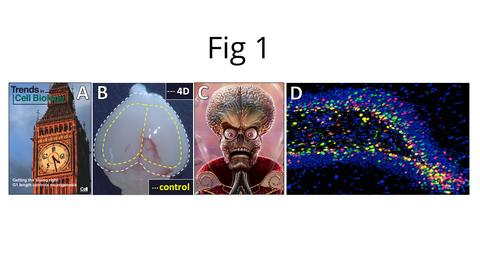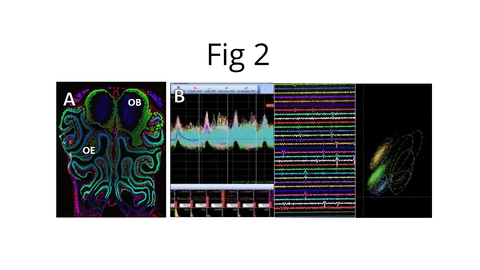Research
It’s a matter of Time: How to give the brain more neurons and protect Earth from Mars Attacks
We found that shortening the cell cycle of NSC promotes their expansion and, as a result, the generation of more neurons (Salomoni & Calegari, 2010; Fig. 1A). Thus, all we needed to do to give the brain more neurons was to force NSC to cycle Fast & Furious. Christian did that by overexpressing Cdk4/cyclinD1 (4D) and, luckily for his PhD and my tenure evaluation, this worked quite well (Lange et al., 2009).
So far so good, we can increase the number of neurons in the brain. But can we also generate mice with bigger and folded brains like humans? More challenging, can we find a student taking such crazy project??? We achieved the latter with Miki making her an offer she could not refuse. The rest was downhill. Miki generated a dual-transgenic, tissue-specific, inducible and reversible 4D line that, needless to say, was called Miki Mouse (Nonaka et al. 2013). However, as big as these brains were, we couldn’t get any gyrus out of them (Fig. 1B). How did gyri emerge during evolution? Was Miki Mouse proof of Intelligent Design? To find this out, we teamed up with Victor’s and expanded ferret NSC, absent in mouse, to finally get new gyri and folds (Nonaka et al., 2013).

Figure 1 A) Getting the timing right: G1 length controls NSC fate. B-C) Miki Mouse has bigger brains (B) and protecting earth from Mars Attacks (C). D) Playing Viral Brain Paint, an experiment that revealed totally useless but nice picture nonetheles.
The next problem was to find editors, and creationists alike, to get the story published. Many journals criticized our lack of novelty since expanion of NSC was already shown to increase brain size and cognition (Wyatt et al., The Rise of the Planet of the Apes. 2011). Hence, we twisted our story noting that, in contrast to monkeys, Miki Mouse and Victor’s ferrets never attacked any students. In turn, this showed that gyrification causes asocial behavior as supported by two very aggressive and highly gyrified species: humans on this planet and Martians on our neighboring planet (Burton et al., Mars Attacks, 1996) (Fig. 1C) (Borrell & Calegari, 2014).
Development is interesting and fun but adult NSC are also useful (so people tell…). Therefore, Benedetta expanded NSC of the adult brain by an overly complicated stereotaxic injection of tissue-specific, temporarily-controlled, tamoxifen-dependent ubb::GFPloxNLS-T2A-Cdk4-T2A-Ccnd1lox HIV-lentiviruses in C57BL/6J nestin::CreERT2 mice (if you got that, you already deserved your PhD). To cut it short, it worked (Artegiani et al., 2011) allowing Sara to improve the sense of smell (Bragado et al., 2019) and Gaby to use a similar, but more colorful (Fig. 1D), method to make old mice feel young again (Berdugo et al., 2020). Since we like movies (you guessed), we made two videos about this. Go on YouTube and enjoy (Sara’s; Gaby’s; Fig. 1F).
Future Goals
If you endured reading thus far, and understand more than the average editor usually does, you can guess our future ambitions. Among these, is to understand how NSC contribute to our sense of smell (Avaro et al., 2022) and how new neurons make mice smarter (Berdugo et al., 2023) (Fig. 2). Humbly, we just wish to improve the most sophisticated machine in the universe: the brain.

Figure 2 A) This is how inside your nose looks like. B-C) Recording the brain (B) and trying to make sense of it (C).
Methods and Tools
We have a lot of fun learning new techniques. You might be surprised to know that sometimes they work. These are some we routinely use (omitted are those that “did not work” as the students tell without further detail).
- Viral-infections in all flavors and colors (Fig. 1D, Artegiani and Calegari, 2013; Berdugo et al., 2020).
- Methods to control gene expression by light (Cambridge et al., 2009), catch transcription factors in the act (Artegiani et al., 2014) and manipulate epigenetic marks (Noack et al., 2019) live.
- All sorts of transgenic mice, can’t remember them all (among others: Aprea et al., 2013; Bragado et al., 2019). I only know that the bill from the animal house is horrendous.
- Playing with in vivo ephys and computational tools (Fig. 2B and C).
